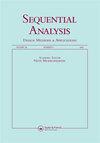A Khmaladze-transformed test of fit with ML estimation in the presence of recurrent events
IF 0.6
4区 数学
Q4 STATISTICS & PROBABILITY
Sequential Analysis-Design Methods and Applications
Pub Date : 2019-07-03
DOI:10.1080/07474946.2019.1648920
引用次数: 1
Abstract
Abstract This article provides a goodness-of-fit test for the distribution function or the survival function in a recurrent event setting, when the inter-event time parametric structure is estimated from the observed data. Of concern is the null hypothesis that the inter-event time distribution is absolutely continuous and belongs to a parametric family , where the q-dimensional parameter space is neither known nor specified. We proposed a Khmaladze martingale-transformed type of test (Khmaladze, 1981), adapted to recurrent events. The test statistic combines two likelihood sources of estimation to form a parametric empirical process: (1) a product-limit nonparametric maximum likelihood estimator (NPMLE; Peña et al., 2001a) that is a consistent estimator of F, say, and (2) a point process likelihood estimator (Jacod, 1974/1975). These estimators are combined to construct a Kolmogorov-Smirnov (KS) type of test (Kolmogorov 1933; Smirnov, 1933). Empirical process and martingale weak convergence frameworks are utilized for theoretical derivations and motivational justification of the proposed transformation. A simulation study is conducted for performance assessment, and the test is applied to a problem investigated by Proschan (1963) on air-conditioning failure in a fleet of Boeing 720 jets.在存在重复事件的情况下,用ML估计拟合的khmaladze变换检验
摘要本文对递归事件环境中的分布函数或生存函数进行了拟合优度检验,当根据观测数据估计事件间时间参数结构时。值得关注的是零假设,即事件间时间分布是绝对连续的,并且属于参数族,其中q维参数空间既不已知也不指定。我们提出了一种适应于复发事件的Khmaladze鞅转换型测试(Khmaladz,1981)。检验统计量结合了两个估计的似然源,形成了一个参数经验过程:(1)乘积极限非参数最大似然估计量(NPMLE;Peña et al.,2001a),例如,它是F的一致估计量;(2)点过程似然估计器(Jacobd,1974/1975)。将这些估计量组合起来构建Kolmogorov-Smirnov(KS)类型的检验(Kolmogorov 1933;Smirnov,1933)。利用经验过程和鞅弱收敛框架对所提出的变换进行理论推导和动机论证。对性能评估进行了模拟研究,并将该测试应用于Proschan(1963)研究的波音720喷气机队空调故障问题。
本文章由计算机程序翻译,如有差异,请以英文原文为准。
求助全文
约1分钟内获得全文
求助全文
来源期刊

Sequential Analysis-Design Methods and Applications
STATISTICS & PROBABILITY-
CiteScore
1.40
自引率
12.50%
发文量
20
期刊介绍:
The purpose of Sequential Analysis is to contribute to theoretical and applied aspects of sequential methodologies in all areas of statistical science. Published papers highlight the development of new and important sequential approaches.
Interdisciplinary articles that emphasize the methodology of practical value to applied researchers and statistical consultants are highly encouraged. Papers that cover contemporary areas of applications including animal abundance, bioequivalence, communication science, computer simulations, data mining, directional data, disease mapping, environmental sampling, genome, imaging, microarrays, networking, parallel processing, pest management, sonar detection, spatial statistics, tracking, and engineering are deemed especially important. Of particular value are expository review articles that critically synthesize broad-based statistical issues. Papers on case-studies are also considered. All papers are refereed.
 求助内容:
求助内容: 应助结果提醒方式:
应助结果提醒方式:


